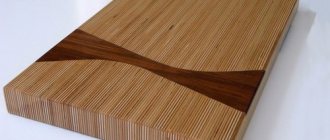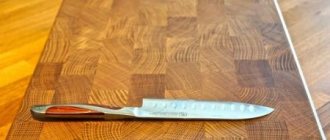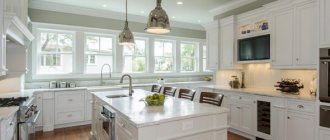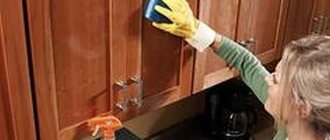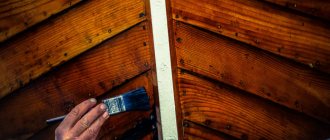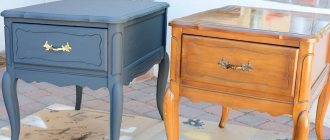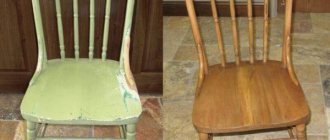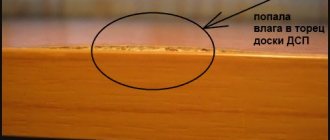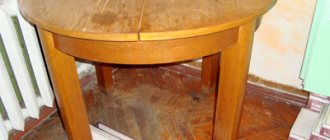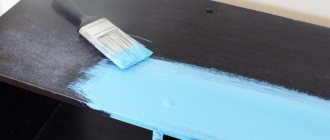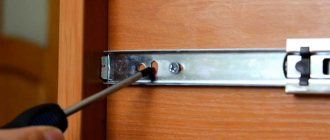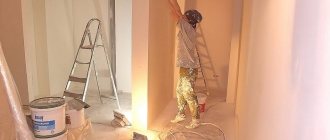The smell of strong morning coffee fills the cozy kitchen. You want to be here all the time, inhaling the aromas of freshly prepared food - fried meat, mushroom soup, sweet freshly baked muffins.
Here you want to meet in the evening, have leisurely conversations after a working day, spend the weekend doing pre-dinner chores for the family, or just sit, when your family has already fallen asleep, with a cup of herbal tea. Yes, right here, behind this kitchen wooden countertop - warm, cozy, welcoming... and, it seems, eternal.
When choosing a kitchen set, the consumer is faced with the question of selecting a surface for the work area, i.e. countertops. This surface experiences enormous loads and strength tests every day. However, there is no way to do without it.
A large number of people give their preference to wood. Natural, warm, durable and textured material will not leave anyone indifferent. However, there are a number of nuances due to certain operating rules that you must know and remember when purchasing.
Wooden countertops are very popular due to their positive properties.
Features of a wooden table top
Wood is an excellent material from which furniture is made. Inexperienced and little-informed people in this matter worry about the possibility of fungus, mold, and cracked varnish. Professionals think differently. In their opinion, a wooden countertop is no worse than its analogues made of artificial stone, for example.
Using the necessary and proper care, the tree will please the eye for a very long time. There are practically no materials used in the kitchen that are weakly subject to wear and tear. The peculiarity of wood is that it can age gracefully. In order to save money, you can make only the surface of the working area from a natural component, which will combine well with individual decorative elements.
Important Features and Tips
Coniferous wood tends to yellow over time, so you should choose light or gray stains. It is recommended to use only varnishes that are resistant to fading.
Experts recommend first testing the impregnation on a prototype and coating the surface with varnish. That is, process the sample completely to the end: this way the result of the combination of stain and the selected varnish will be visible, which will allow you to check whether the tone created as a result of the “collaboration” of these two substances is suitable for the master.
Wood, and especially its conifers, has a certain degree of unpredictability in the light of the work we describe. There is a possibility of tonal color changes occurring over time.
Containers used during operation must be as clean as possible and consist of identical material. If impregnations are mixed, then this must be done extremely carefully in the same container. If it consists of metal, then its impurities may slightly change the tone.
To create tones in the light or gray range, you should select wood that is as close to them in color as possible. In addition, the result largely depends on the structure of the tree. For example, it is influenced by the quality of the solid rings of this material.
How to cover the tabletop
Having decided on the material, you need to understand that the optimal surface for the table will only be natural wood. In no case is veneer, MDF or chipboard used. Particular attention is paid to the age of the tree, its place of growth, and storage conditions.
It is important to know that a laminated wood surface will be more elastic and flexible than the same surface made from solid wood. The type of raw material is also important. Care methods must necessarily include treatment with special protective agents. What is the table covered with? It can be varnish, wax or oil. There are three options for covering the table surface: varnish, wax and oil.
Practicality or durability
In order not to make a mistake in your choice, you should keep in mind some features of tree species. Harder ones, such as oak or beech, will last longer. However, their cost is much higher.
Among the democratic ones, pine, birch, ash or larch are perfect. Speaking about the latter, we should note a number of advantages. Its surface is quite dense and resistant to various types of damage. The presence of gum in the composition prevents the growth of fungi and mold, as well as rot, which is very important considering where it will be used. Larch is also capable of absorbing or releasing excess moisture.
Oil, wax or varnish
Avoiding the harmful effects of water, temperature, acid and alkali will help extend the life of a wooden tabletop. Here the question immediately arises of how to cover a wooden tabletop so that it lasts a long time.
Among those available, processing using the following means is suitable:
- oil;
- wax;
- varnish
Surface treatment with oil, or rather its impregnation, is the optimal way to protect wooden products. It provides a kind of barrier that repels water from the surface. Oil absorbed into the top layer of wood will prevent it from getting wet when in contact with water. Oil compositions are not washed off, but require frequent use. At the moment, you can choose different compositions that match the color. Oil protects wood from moisture.
Wax is a natural and environmentally friendly material. The effect of its use is similar to oil. But in addition to protecting against water, the wax coating also protects against minor mechanical impacts (scuffs and scratches). However, there are also disadvantages. A wax coating wears out quickly and requires updating and polishing more often than an oil coating. Before this, the old layer is cleaned off.
Using varnish on a wooden tabletop is a radical method. It protects wood from water, minor mechanical damage, and exposure to ultraviolet radiation, while the structure of the tree itself does not change. The color of the surface remains the same, and a natural exchange of moisture also occurs, preventing the appearance of fungi and mold.
This coating also protects against temperature influences without flaking or cracking. To remove the varnish coating, the tabletop will have to be scraped.
Can chipboard replace natural wood?
Chipboard (chipboard) is a composite material that contains chips mixed with resin. By far, this is the most popular material for making countertops.
If you don’t see the point of spending money on a kitchen top made of natural wood, but want an aesthetic product with good performance characteristics, pay attention to the following options:
Veneered chipboards
Photo from source: zakazat-mebel.ru
The surface is covered with veneer - a thin layer made from natural wood. A protective layer of varnish is applied on top.
Visually they do not differ from solid wood countertops. Disadvantages include an average level of resistance to chemicals and scratches.
Melamine cladding
Photo from source: sdelai-lestnicu.ru
In this case, the chipboard is finished with kraft paper, which is impregnated and coated with melamine resin. Resistant to solvents and moisture.
They can have any pattern, including the texture of natural wood.
Lamination with plastic
Covered with HPL plastic. It is resistant to UV rays, mechanical stress, moisture, food acids and any household chemicals. They are durable and easy to maintain. These are beautiful, varied products.
They give the greatest scope in terms of design. On the market you can find decors with very high-quality imitation wood or stone.
If you are looking for a high-quality countertop with an affordable price tag, then pay attention to chipboard with HPL lamination.
A photorealistic imitation of an array will please the eye, reliability and ease of maintenance will eliminate additional expenses and worries, and a high level of environmental friendliness will allow you not to worry about the health of your family.
It is these advantages that we have embodied in the “Cedar” line of countertops. Our task is to provide the client with a high-quality, aesthetic and durable product at an affordable price. Get more information on the official product resource.
Table top Cedar 690/P Indian wood
Coating process
Proper treatment of a wooden surface is the key to its long service life. This rule especially applies to kitchen countertops. In addition to the fact that you need to choose the right treatment product, it is also important to properly prepare the surface, apply protection and dry. The following describes the process of how to coat surfaces using oil compositions as an example.
Preparing the wooden surface
The first step will be to clean the countertop from all kinds of dirt and greasy marks. Next it is dried.
On a note! The wood moisture content should be no more than 12% according to DIN EN 13183-2.
To ensure that the oil adheres well and is absorbed, the wood is sanded, starting with coarser abrasives, gradually moving to finer ones. Also, after each abrasive, the coating is cleaned. You may need to putty it to remove deeper scratches. A special restoration kit based on wax is ideal.
Preparation of the product
The main thing you need to pay attention to when choosing a coating is its quality. A good protective agent will protect the wooden surface from mechanical damage and moisture and give it a shiny, renewed look. The coating must be of high quality to provide the furniture with protection and a well-groomed appearance.
The product must also be prepared. Before treating a wooden countertop in the kitchen, the composition must be thoroughly mixed for 5 minutes. The product must be mixed well.
Application
The composition is applied with a brush or cloth, and the latter should not leave lint on the surface. It will take about 12 hours for the first layer to dry. Then you can apply the next one, and so on. The number of layers will directly depend on how the product is applied. Using a brush, two treatments are enough; a fabric coating will require up to 4 layers.
Use a brush or cloth for application.
When the product is well absorbed, the entire treated area is thoroughly wiped with a soft and clean cloth.
After the product has been absorbed, wipe the surface with a cloth.
Drying
Drying time varies from several hours to several days. Naturally based oils or mixtures containing acrylic require a longer drying period. They can also increase strength gradually. It is important not to use a freshly treated countertop for a while.
After applying the coating, it is important to let the furniture dry.
Dyeing technology
Before you paint a wooden table, you need to arm yourself with:
- with a brush, roller and container (if paint is used) or spray (aerosol);
- goggles, mask, gloves, respirator (to avoid toxic substances getting into and on the body);
- antiseptic (necessary for protection against insects) and wood primer (reduces paint consumption).
If you choose the color yourself, apply the mixed paint to the surface and let it dry to understand what the final color will be. Painting the table is done on a hard surface, previously covered with newspapers or plastic wrap to avoid paint getting on the floor.
For those who decide to cover the table with varnish or non-water-based paint, it is better to carry out the restoration outdoors due to the strong toxic odor. If the piece of furniture is large enough, it is better to disassemble it into its component parts using a screwdriver, hammer drill, etc. Many experts argue that it is not worth violating the integrity of a wooden object, since in the future it may lose its shape. However, this statement is controversial. If you assemble all the parts together correctly and efficiently, this will not affect the life of the product, and it will be easier to paint. Before repainting a varnished table, you must remove the old coating. To do this, you can use a chemical solvent, a spatula, or a metal sponge. At the initial stage, sandpaper should be selected coarse-grained, which does not abrade the surface so much. Next, you should sand the surface with fine-grained sandpaper, cover it with an antiseptic and primer and leave to dry. An antiseptic is needed so that pests cannot subsequently reach the wood. After the primer has dried, the surface must be sanded again and wiped with a dry cloth or vacuum cleaner.
Sanding the table surface
The paint is applied in at least two layers
Masking tape is useful if the wooden product has glass or plastic inserts that do not need updating. It is enough to seal unnecessary places and you can proceed directly to painting. If you use aerosol paint, be sure to wear a respirator, goggles and gloves. These methods of protection allow you to paint a wooden tabletop without harm. The substance should be sprayed at a distance of 30 cm from the wooden table. Next, you need to leave the product to dry, and then cover the wooden table with another 2-3 layers of paint. The same sequence is maintained when using conventional liquid paint, which should be applied with a roller or brush with soft bristles. To make sure that the furniture is ready for the next treatment, it is recommended to lightly touch the edge of the surface with your finger. If the paint does not stick, then you can proceed to the next step.
How to paint a tabletop, how to choose a varnish for a table? What varnish to cover the table with depends on the further purpose of the product, but the most universal coating option is acrylic varnish, which will protect the wooden surface from mechanical damage. After painting, you need to remove the masking tape and leave the product to dry for 8 hours (or better yet, a day). Only after this is it ready for use.
Before applying the varnish layer, the table can be decorated with decorative fragments
Pros and cons of wooden surfaces
Wood can be called the best material for making kitchen furniture. But, as with everything and everywhere, there are advantages and disadvantages. The first include:
- environmental friendliness;
- good thermal insulation;
- natural appearance;
- variety of forms;
- variety of colors, shades;
- ease of restoration work.
Wooden flooring in the kitchen has many advantages.
To the second:
- rapid contamination;
- possible fire;
- susceptibility to mechanical stress;
- quite high cost.
Among the disadvantages are the possibility of fire and the high cost of the material.
There is absolutely no need to be afraid of using wood in the kitchen. This is a good solution for modern headsets.
"Casker"
The material of the “Kasker” series is quartz composite.
The highest priced countertop is a product made from special quartz stone. The peculiarity of this material lies in the properties of the material. Firstly, the main advantage of the composite is its strength. It was she who attracted kitchen furniture manufacturers. Secondly, the absence of pores makes this material almost 100% moisture resistant, which is its advantage among other materials used in the manufacture of kitchen countertops.
Tabletop care
Proper care will extend the life of your wooden countertop. However, during the preparation of a culinary masterpiece, and more than one, the surface can be subject to all sorts of influences, from scratches with a knife, hot dishes to spilled water or a fallen frying pan.
In order for the countertop to last a long time, it is necessary to properly care for it.
Following these rules will help you save money and nerves:
- using cutting boards rather than table surfaces;
- it is better to use special stands for hot dishes on the work surface;
- no prolonged exposure to water;
- cleaning the countertop with soft brushes and sponges to avoid damage;
- removing various stains using a soft cloth and a neutral product without abrasives;
- timely sanding of small scratches and stubborn stains with fine abrasive sandpaper;
- using a special wood polish;
- Caring for a wooden countertop should be daily and regular.
It is important to use cutting boards while working.
By following the rules of caring for wooden surfaces, you can enjoy the beauty, warmth and comfort of your kitchen for a long time.
Summarizing the above, we can highlight the following: a wooden countertop is an excellent solution for a work area in the kitchen; the correct choice of wood, careful handling, proper care and timely treatment with protective agents, and, if necessary, restoration, will help preserve the natural beauty and durability of the tree.
"Ekbakken"
Composition of materials for the Ekbakken countertop:
- polypropylene;
- laminate (melamine).
Reviews about the Ekbakken countertop from IKEA contain only positive aspects. This is due to its strength and durability. The moisture-resistant structure of melamine from which the tabletop is made allows it to be used in close proximity to the sink. And product options in different colors allow you to use it in kitchen compositions in any interior.
How to treat a wooden tabletop?
The surface of the table in the kitchen is an essential part of kitchen furniture; it is subject to constant mechanical stress and is damaged over time. Therefore, owners of kitchen furniture ask themselves an important question: - How to cover the countertop so that it does not lose its presentation for many years?
In the kitchen, the top of the table or the area located on top of the floor cabinets is used as a work area for cutting food and preparing food, as well as a place to place household appliances and kitchen utensils. Such a working area must be resistant to shock and various mechanical damage, to the effects of temperature, ultraviolet radiation and water.
Features of wood countertops
Kitchen sets are made using various raw materials, such as wood. It can be either natural, that is, without a special composition applied on top, or coated with varnish or paint.
The table provides data on wooden tables.
Characteristic Description
| Design |
|
| Material | The wood material can be anything, but the most commonly used are cherry, walnut, oak, and maple. Exotic woods are used less frequently (teak, rosewood). |
| Shape of the finished piece of furniture | Ready-made pieces of furniture for the kitchen can be of various shapes: rectangle, oval, circle, corner shape. |
The advantages of countertops made of wood are:
- a large number of different forms;
- attractive appearance;
- ease of carrying out restoration work;
- This material is environmentally friendly and warm.
The disadvantages of countertops made from wood raw materials are:
- ease of fire;
- ease of contamination;
- can be scratched easily;
- is quite expensive.
Uniform tinting of pine: 4 steps for a perfect result
In retail outlets, there are often many other related species in stacks of finished pine boards, but sellers do not make much distinction between them, calling everything “pine.” Such species are very close in botanical classification, but still, they are not quite pine and they have slightly different properties. That is, they will absorb stain differently. However, this is also observed in pure pine: even the same board can have a different resin content and different absorbency in different areas. What can we say if the boards chosen are from different trees.
Unpredictability is something to consider when starting to use stain for this breed. To determine its level and boundaries, test samples are used. This is the most reliable method to check the quality and parameters of the material.
Ways to protect your kitchen work surface
The working area of the room in which food is prepared is exposed to various liquids, so in order for it to serve for many years, it must be protected from water.
There are several ways to do this:
- Use oil to treat objects made of wood, which is absorbed into the material and prevents the fibers from swelling when wet. The following industrial products can be used for wooden surfaces: OSMO TopOil, Belinka, Adler Legno or many others. To treat the work area together with this substance or even instead of it, use a special wax. But it is necessary to remember that such a product will have to be renewed over time, that is, applied again.
- Treat it several times with a special varnish for wood surfaces. If desired, a little pigment is added to it so that the deep fibers of the wood become darker, and the cooking surface itself acquires expressiveness.
Oil coating for kitchen units
Oil protects furniture from not only moisture, but also from chemical, natural and household influences. This industrial product is largely colorless and can be plant-based, mineral-based or synthetic.
These coatings differ from each other in the drying method:
- It dries completely, hardens after drying, it cannot be washed off with water and the original appearance of the treated furniture is preserved for quite a long time.
- It does not dry at all or dries only half and saturates the wood quite deeply. It is made using natural ingredients. It is removed using mechanical force.
Before applying such a product, the surface to be treated is thoroughly cleaned of all contaminants and dried. If necessary, old paint or varnish will have to be removed. And if there are defects, they must be leveled with a special putty and then sanded with sandpaper.
The oil is applied using a brush or cloth that does not leave lint, it is applied along the entire length of the fibers. The very first layer should dry for twelve hours, then a new layer is applied. Their total quantity in this composition depends on the method in which the product itself will be applied. If a brush is used, two treatments will be done. And when using a rag, you need to do three or four layers. After the composition is completely absorbed, the entire treated area should be wiped well with a soft and clean cloth.
The presented coating has a number of positive properties:
- Does not change the color of the surface for working with food, emphasizes its “pattern”.
- It leaves the original natural exchange of moisture in the surface and prevents the appearance of fungi, so the original appearance of the treated area does not change for a long time.
- If the outer part of the object for such treatment is exposed to elevated temperatures, then the product does not delaminate and does not flow.
- Furniture oil is environmentally friendly, so contact of food ingredients with a surface containing the described composition will not harm human health.
- Oil hides small scratches, worn areas and stains left by cookware.
- If there is a need to renew contaminated areas, you can remove only part of this coating, and then reapply it to the desired areas.
- The oil is well suited even for aged wood containing pores, as it is deeply absorbed, gives it elasticity and prevents it from drying out.
Wood preparation
Before applying stain, the surface must be moistened and dried. This will prevent the fibers from deforming immediately after processing. After these two stages, the wood must be sanded. The grit size of the grinding tools should be 120 – 150. After cleaning from dust, grind with an abrasive of 150 – 180 grit and then thoroughly clean it from dust again. Desirable wood parameters: temperature > +15 C°, humidity 8 – 12%.
It is highly advisable to treat resinous pine wood with a product to remove resins.
Updating the tree workspace
No matter how carefully the work area in the food preparation room is used, over time it still loses its original appearance. After which you can either buy a new headset or try to update it. Painting is the easiest way to update.
To paint the work area, do the following:
- clean the tabletop with sandpaper or a sanding machine;
- cover up all defects with special putty;
- walk over the surface to be treated with paint containing alkyd resin; the very first application of this paint will serve as a primer;
- if you wish, you can decorate the surface for kitchen work (draw something yourself or using stencils).
You can decorate the working part of the kitchen furniture using the decoupage technique. This technique consists of gluing decorative napkins onto the item being renewed, and then varnishing them several times.
Another way to update is to use a film of self-adhesive material, which allows you to give the updated item the appearance of a wood surface, stone, marble, leather or metal. Before gluing, the part of the furniture to be treated will have to be washed thoroughly, wiped dry and be sure to degrease.
Before using self-adhesive film, determine the dimensions of the area that needs to be updated in order to cut the film correctly. Pieces of this film should be cut slightly larger than the table itself. After gluing, do not leave any bumps or folds on the film. Smoothing the film is done with a plastic scraper.
Preparing the surface for painting
The countertop that you plan to paint must be clean, intact and dry. Fill all chips and cracks with putty, after drying, clean these places, or better yet, the entire surface as a whole. This will not only get rid of differences and unevenness, but also give the surface roughness, which will improve paint adhesion.
If the tabletop is very old, with multiple damages, and you doubt that you will be able to repair them perfectly, it is better to make an overlay - for example, from an MDF sheet or moisture-resistant plywood. By screwing such an overlay to the surface, you will get a smooth surface ready for painting. Only the edges need to be sealed with putty.
To improve paint adhesion, use a primer that matches the material of the countertop (primer for wood, primer for mineral surfaces, etc.). Or use a universal primer. Allow the primed countertop to dry before you begin painting. Not only the top layer, but the entire countertop as a whole should be dry. Some materials (wood, unglazed ceramics) absorb the primer especially actively, so it is better to continue the work the next day.
Caring for your cutting board
No matter what material the kitchen countertop is covered with, it is better to cut food not on it itself, but on the surface of the cutting board. The raw materials for creating a cutting board can vary. Kitchen boards can be made using plastic, special glass or wood (most often chosen because it is a natural antiseptic).
A new cutting board needs to be soaked, for which oil is suitable. This impregnation will protect it from liquid, food and bacteria getting inside it.
The oil layer of the board should be harmless to health and resistant to various damages. If you use sunflower or olive-based oil to cover the cutting surface, it may deteriorate after some time, and the board will need to be thrown away. Products based on coconuts or flax are expensive, but will not allow the cutting surface to become unusable.
Mineral-based oil is a good option for coating a cutting board. To do this, wipe the cutting board with it, wait until the composition is absorbed, and wipe it with a dry cloth. The procedure must be repeated once every thirty days.
Beeswax can be added to this cutting board coating to add density to the coating. Wax will increase resistance to moisture and prevent aging of the cutting board. After applying the oil and wax, you will have to let the product dry and then polish the outside of the board until it shines.
You should also remember to disinfect the board for cutting ingredients for preparing dishes. You can disinfect cutting boards using these methods:
- hot water and detergent containing surfactants;
- vinegar;
- hydrogen peroxide;
- chlorine-containing bath cleaning products.
Pine primer
Experience in processing pine wood shows that applying stain to its clean surface leads to uneven tone and staining.
The carpenters conducted an experiment with test samples to determine which primer composition would provide better color uniformity. The surface was treated with shellac for furniture, a factory primer-conditioner for wood with uneven absorption and a polyurethane composition. The latter showed the best result.
After applying and drying the composition, the surface is lightly sanded in the direction of the fibers with a sponge with abrasive No. 320 and a liquid stain is applied.
Restoring a wood countertop
Under the negative influence of liquid and high temperature, the top of the table may become higher, become loose or delaminate, after which the wooden surface must be restored.
Restoration is carried out as follows:
- all damaged areas must be removed;
- dry and sand the outer part of the table to be restored;
- make a mixture containing sawdust and polyvinyl acetate glue;
- fill all the empty spaces in the table that appeared after sanding with the resulting mixture; wood putty is also suitable for these purposes;
- leave the restored item under pressure until it dries for about one day;
- As soon as the table is completely dry, it must be protected with a product containing silicone, oiled or varnished over the entire area of the object.
To remove small scratches, you can wipe the problem area with strong brewed black tea, a walnut kernel, a mixture of vinegar and olive extract, and you can also use machine oil.
If there are scratches on a wooden surface that are deep, then sandpaper is used to sand it, and then sanding. And to give the effects of glossiness and shine, you will have to use felt.
As a result of all of the above, we can conclude that to keep a wood kitchen countertop in good condition, it is best to coat it with an oil-based compound with the addition of wax. And to preserve the board for cutting food, it would also be good for her to do this application. Then these items will serve for a long time, provided that their protective coating is updated in a timely manner.
Description and characteristics of shields
- Finger-joined furniture panels
This is a wood board formed from lamellas glued along the width and spliced along the length - wooden blocks. Along the length, the lamellas are fused into a mini-tenon. Along the width they are glued together into a smooth fugue. The method is reliable and is used in the manufacture of standard products in 100% of cases.
Compared to solid-lamella structures, spliced panels are considered more reliable, since the tension of the fibers in adjacent bars is uniform and, accordingly, the entire structure is more stable and durable.
- Solid lamella furniture panels
This is a wood board formed from lamellas glued together only along the width. The gluing method is using a smooth fugue. The width of the lamellas is 40-45 or 25-30 mm. Thickness varies from 10 to 150 mm.
Compared to spliced ones, solid-lamella structures have a more uniform texture and color range, since they consist of fewer lamellas.
Practicality and durability
There are two main requirements for a wooden tabletop: it must be practical and durable.
Advantages of wood:
- Eco-friendly, safe to use and dispose of.
- Natural color enhances any interior.
- Pleasant tactile sensations from warm natural material.
- Ease of making different shapes.
- Never goes out of style.
- Natural wood fits into almost any kitchen style.
Flaws:
- Requires careful care.
- Easily damaged.
- Fire hazardous.
- Expensive.
- Heavy in weight.
The durability of a wooden tabletop depends on the source material and manufacturing method.
Hardwood trees are used. A tabletop made of oak or beech will last a long time. Surfaces made of ash, walnut, birch, and pine are more affordable. Many manufacturers prefer larch - an expensive but durable material.
Its features:
- dense wood;
- resistant to mechanical damage and stress;
- the composition contains gum - a natural antiseptic that protects against mold, mildew, and prevents the process of rotting;
- When temperature changes, it releases and absorbs moisture.
Solid surfaces are subject to curvature. Glued wood, that is, assembled from several plates, is as flexible and elastic as possible.
Practicality is due to resistance to moisture, temperature changes, and strength.
Stages
If the master has chosen pine as a material for the floor or other elements of the room, then you need to take into account the properties of this wood when processing it with stain and varnish. The steps for proper operation are:
- Buying high-quality “correct” boards.
- Grinding.
- Primer.
- Impregnation with stain.
Many carpenters and woodworkers love pine because it is easy to work with, light weight, and low cost. In addition, this wood is available everywhere.
When finished with transparent materials, the pine surface seems to radiate warm sunlight. This effect is rarely found in other breeds.
Fewer problems arise when the task is to preserve or emphasize the natural color. But if you need to give it darker shades, then the result of impregnation with stain will often be unpredictable. This is due to the fact that, due to resin substances, pine wood has different absorbency in certain areas. The unevenness of this process makes the surface mottled or with stripes that differ in tone.
Because of this drawback, you should not refuse to process such material. You can tint pine boards evenly if you know the technology and how to do it correctly. This will require only a few simple steps and a little more time to prepare the wood.
Oil, wax or varnish
In order for a wooden tabletop to serve for a long time while maintaining an attractive appearance, it is covered with a protective layer. It saves it from moisture, aggressive detergents, extends its service life, and saturates the natural color.
Interesting! A popular color is Venetian oak.
Manufacturers of kitchen sets and woodworkers know how to process a wooden countertop in the kitchen. Three options are recommended: varnish, oil, wax.
Varnish
Advantages of varnish coating:
- The wood pattern and rich color are better visible;
- several layers prevent surface destruction;
- protection from moisture;
- durability.
The varnish treatment is suitable for both the kitchen table and the countertop. Experts recommend polyurethane and acrylic varnishes.
When using them, table and tabletop:
- will retain its appearance for a long time;
- will withstand cold and hot dishes on its surface;
- will be reliably protected from contamination.
Oil
Special wood oil creates a water-repellent film on the surface. Oil products are made from plant, mineral and synthetic raw materials.
Depending on the drying process, they are divided into:
- Partially dry. Deeply impregnate the wood. The top layer is removed mechanically.
- Completely dry. A hard layer forms on the surface. It does not wash off with water.
Benefits of oil coating:
- highlights the natural color of wood;
- does not exfoliate;
- completely absorbed and does not flow at high temperatures;
- prevents the formation of fungus;
- does not cause harm to health when in contact with food;
- hides abrasions and minor scratches.
Wax
Wax is a good option for coating a wooden surface:
- makes the surface waterproof;
- prevents the appearance of mold and mildew;
- Withstands common kitchen detergents.
Main types of wood varnish
First, a few words about the functions of furniture paints and varnishes. It is advisable to choose a composition that simultaneously:
- will protect the wooden base of furniture, which is often washed, food is spilled on it, scratched with household items, and heated with hot dishes;
- will improve the appearance of surfaces that are always in sight, maintaining a festive look, shine or velvety matte for a long time;
- will not spoil food, contact of the table surface with food is inevitable, varnish for a wooden tabletop should not contain toxins or other components hazardous to health.
For reference! Paints and varnishes are produced for external and internal work, this is worth taking into account.
Types of varnish coatings used in the production and restoration of wood furniture:
Alcohol based. When dried, the alcohol evaporates from the composition, the dissolved resin hardens, forms a transparent or translucent layer with a glossy sheen. The varnish reliably protects the table base from moisture and mechanical damage. Pleasantly emphasizes the wood texture, slightly thickens the natural shade
When purchasing paints and varnishes, pay attention to the concentration of the base; the recommended alcohol strength is 90%; if lower, the protective layer will not be as strong. It is better to cover the countertop with a concentrated mixture. Oily. Thick varnish is a mixture of resin, pigment and mineral oil (petroleum product)
It is better to work with such paintwork materials outdoors. When dry, the varnish forms a durable film that is resistant to precipitation, ultraviolet radiation, and “kitchen risk factors.” The downside of the composition is its persistent yellowness, which makes the furniture look old. Nitrovarnishes. The basis of the mixture is organic solvents, the film-forming component is cellulose. There are no complaints about the strength or appearance of such coatings, but they are not safe. Organic solvents are too toxic. Harmful components of the mixture will pollute the atmosphere of the room even after the surface layer has completely dried. Due to the persistent odor and toxicity, manufacturers are gradually reducing production volumes of nitro varnish, and demand for it is falling. You should not cover a wooden countertop in the kitchen with this varnish; it is better to choose a safe composition. Water-based paints and varnishes. Water-based varnishes are safe and absorb well into wood. Due to acrylic dissolved in water, after drying the varnishes form a durable polymer film that hardens more and more over time, is heat-resistant, and not prone to abrasion. Water-based acrylic varnish is not afraid of water, it is transparent, and does not change color from ultraviolet radiation. Preserves the original wood grain and emphasizes the texture of the countertop. Polyurethane mixtures. They are elastic, resistant to cracking, and easy to use - no need to prime the wood. The varnish layer is not afraid of accidental impacts, static and dynamic loads. The paintwork dries quickly and does not emit harmful substances. The coating is safe, retains transparency, does not turn yellow, and looks great. But there are also disadvantages: it is better not to purchase polyurethane varnish for a wooden table; the moisture resistance of the coating is quite low.
How to protect your kitchen work surface
The tabletop is one of the main workplaces of the housewife. The surface tolerates mechanical, thermal, and chemical influences.
To make kitchen surfaces, manufacturers use the following materials:
- Chipboard, MDF;
- solid wood;
- acrylic stone;
- glass;
- agglomerate - artificial stone;
- stainless steel;
- ceramic tiles;
- granite, marble - natural stones.
To protect your kitchen surface, follow these rules:
- Use cutting boards on countertops made of any material.
- Wipe down chipboard surfaces. They swell from drops of water and food debris. Forks and knives left on the table scratch the surface.
- Countertops coated with varnish or paint should not be cleaned with abrasive detergents. The use of metal brushes and hard sponges is prohibited.
- It is not recommended to place hot dishes on any surface.
It is difficult to protect kitchen countertops from minor damage. Splashes of water, grease, sharp cutlery, hot and cold dishes cause stains, chips, and bloating.
Wooden tables and countertops in the kitchen are more vulnerable to various types of damage than surfaces made of other materials.
There are several ways to hide the resulting flaws:
- Small scratches are wiped with a cotton swab soaked in strongly brewed black tea and machine oil.
- Deep cuts are treated first with coarse sandpaper, then with fine-grained sandpaper and polished with felt.
- Minor abrasions are revealed by the pale color. They are soaked in black tea. Deep ones that have passed through all the protective layers of the coating require cleaning and applying a new layer of oil or varnish.
- The darkened countertop is treated with a weak solution of hydrogen peroxide.
- Lemon juice removes stubborn stains.
To protect your kitchen table and wood countertop:
- use self-adhesive film;
- when installing the headset, a silicone layer is laid between the tabletop and the wall, which protects against moisture;
- use stands made of plastic and wood.
Self-adhesive films are especially popular for protecting kitchen furniture. They are:
- Transparent. Then the natural color of the wood remains visible.
- With designs imitating ceramic tiles, mosaics, depicting animals, plants, fruits, etc.
They are glued to areas near the sink, cabinets, aprons, and dining tables are updated. Self-adhesive film for kitchen countertops is impractical. Moisture and detergents quickly deteriorate.
Proper grinding
A step-by-step proven method on how to properly sand a pine board:
- to begin with, you can take coarse-grained discs for a grinder and, changing them in descending order, finish the procedure with disc No. 180;
- then, additionally sand it manually using a block with sandpaper No. 180. It is necessary to move along the fibers: this will remove marks from the sander;
- The final stage is sanding the ends with sandpaper with grit No. 220. This will prevent them from excessively absorbing the stain.
Care instructions
In order for a wooden tabletop to retain its appearance longer, it is necessary to properly care for it:
- The wood is wiped with mineral oil. It adds shine and prevents the growth of harmful microbes.
- Every day, remove any remaining water and food, first with a damp sponge, then wipe dry. To clean the countertop and wash dishes, use different sponges and rags.
- Hot dishes, iron containers with sharp edges at the bottom, heavy kitchen appliances are placed on stands.
Practicality or durability?
How to make a countertop practical and durable? Both of these qualities are laid down initially, at the stage of choosing a wooden surface.
What to look for when choosing a wooden kitchen surface?
- You cannot use veneer, MDF, chipboard, only natural wood.
- Has the meaning:
- age of wood;
- place of felling;
- storage conditions.
- Products made from laminated wood are more flexible and resilient than their analogues from solid wood.
- A properly selected coating will protect the wood in harsh operating conditions in the kitchen. Before covering a wooden tabletop with oil or other suitable composition, it is worth studying the available range of coatings, their properties, and features. Even better is to test the chosen product on a small piece of wood.
- It is necessary to clearly define the methods of surface care and the possibility of restoration in case of damage.
A wooden tabletop must be smooth, durable, resistant to moisture, temperature, and cuts. A product made from harder wood will last longer. Classic options for kitchen countertops are oak or beech. Tabletops made of ash, pine, walnut, and birch are more affordable.
Larch works well. Its dense wood is resistant to mechanical destruction and deformation. Gum in larch wood prevents the growth of fungi and rotting, such properties are ideal for difficult kitchen conditions. Larch has the important property of giving up or absorbing moisture when humidity conditions change.
Advantages of wooden surfaces over other types:
- environmental friendliness;
- beautiful texture;
- variety of colors, shades;
- ease of processing, unlimited possibilities in creating different shapes, neat edges with the possibility of various milling;
- ease of updating and repair.
Don't forget about the disadvantages:
- requires more careful care than other types of surfaces
- periodic restoration is required;
- high cost of the material, expensive processing work.
In a situation with wood, you need to remember that all the difficulties in selecting, caring for, and repairing it will more than pay off in coziness, beauty and extraordinary feelings of comfort in the kitchen.
"Gertron"
The “Gertron” series is represented by products made from solid beech wood coated with wood oil. This type of product belongs to eco-products.
Reviews of IKEA countertops from the Gertron series are mostly positive. Most often, the environmental friendliness of the product is noted, as well as its durability. Some consumers talk about the possibility of restoring a damaged surface through light manipulations - sanding the surface and then impregnating it with wood oil.
Oil, wax or varnish?
A high-quality coating with good compounds will give a wooden tabletop a beautiful look and protect it from moisture and aggressive detergents.
How to cover a wooden tabletop so that it lasts as long as possible and at the same time remains beautiful?
- Oil, wax.
- Alkyd coatings.
- Water-dispersed compositions.
Ideally impregnated with oil, oil-wax. Oil, nourishing the wood structure, gives it water-repellent properties. When properly treated with good oil and wax, the countertop becomes resistant to household chemicals and detergents, which are often used for washing kitchen utensils.
A special oil designed to impregnate wood that comes into contact with food will ensure environmentally friendly processing.
You can apply colored glaze, stain, and other water-dispersed coatings followed by application of varnish. The properties of the varnish used, its resistance to moisture, and multi-layer coating are important.
A high-quality coating is carried out in several layers - two or three - regardless of the paint composition. Do not mix alkyd and acrylic coatings. Before covering the countertop with the base compound, it is important to select the appropriate primer.
Advice!
For maximum durability, the coating should be renewed one year after application. It takes time for the product to “get used” to the surface at different temperatures. When exposed to external conditions, microcracks appear on the surface of the coatings, which are visually indistinguishable. Therefore, it will be useful to lightly sand the top layer and apply a new layer with the same composition.
The quality of the coating can be tested in the following way: apply a few drops of water to the countertop and observe how quickly they are absorbed. A good coating has excellent water-repellent properties.
It is important to consider the drying time of the compositions; it can vary from several hours to several days. Natural oils and acrylic mixtures have a long drying period or accumulate strength gradually over time, so it is important to limit the use of the countertop during the drying period.
It is impossible to protect wood from scratches and mechanical influences with paints and oils, so there is only one way out - treat wooden countertops with the utmost care.
How to cover a wooden countertop in the kitchen? Manufacturers and experts recommend varnish, oil and wax.
The ideal solution is a combination of oil and wax. The composition is used as a coating for a wooden kitchen table and work surface. With daily careful care, they will delight you with comfort and warmth for a long time.
We recommend:
- How to cover a roof with corrugated sheets with your own hands: everything...
- How to arrange a kitchen: 10+ types of ideal kitchens and…
- Kitchen-living room design: Real photos
- Varnish for a wooden tabletop: rules for choosing and…
- Do-it-yourself wooden kitchen countertop:…
- Storing pans in the kitchen: in a drawer, on a shelf, in…
How to restore a wooden table
Before you varnish your dining table or kitchen worktop, you should evaluate the condition very carefully.
The surface may already be painted, mechanically processed, glossy, or varnished. Regardless of what varnish the surface will be coated with, it is necessary to carry out preparatory work. In the video: how to cover a table with stain.
Preparation
The first step is to remove all the old coating. This is done so that the texture of the wood is clearly visible, using an electric tool. When the table is as smooth as possible, the surface does not have any defects, then you can move on to the next stage.
Removing old coating
The chemical remover is applied to the table surface and then wiped off after 10 minutes. To apply and remove a layer of paint or varnish, use a rag.
You can also remove the old coating by sanding. Doing this by hand takes a very long time, so it is better to use a power tool. The work is performed at low speeds so as not to damage the wood.
Varnish application technology
To apply varnish, it is better to use brushes or rollers. Using a colorless varnish for a wooden table in one layer, it is very difficult to obtain the desired shade - this is only possible if you cover the surface in several layers.
After the stains and primers have dried, they can be varnished. The varnish is applied in a thin, even layer, trying to avoid drips. After the first layer has dried, it is recommended to sand the surface. For a high-quality result, varnish in three layers of varnish.
In a day, the old table will turn into a new one and no one will ever be able to say that it is very old. Knowing how to cover a table, you can restore other wooden furniture in this way.
